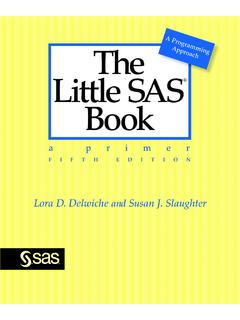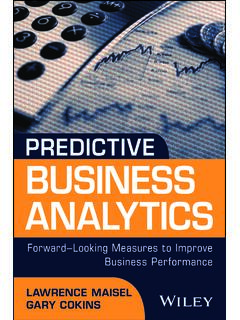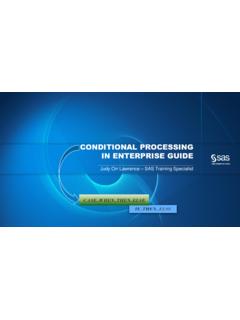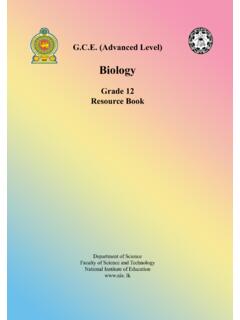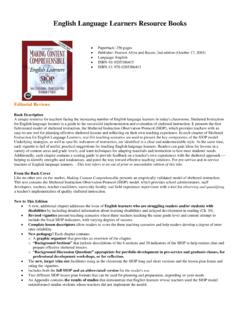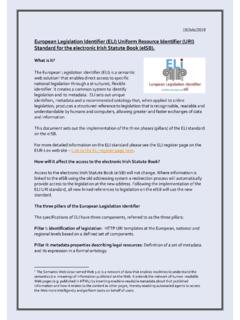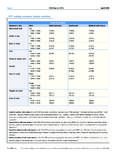Transcription of SAS Functi ons by Example
1 Ron CodySAS Functions by ExampleSecond EditionSAS PressContents List of Programs vii Preface to the Second Edition xix Preface to the First Edition xxi Acknowledgments xxiii Introduction xxv Chapter 1 Character Functions 1 Introduction 3 Functions That Change the Case of Characters 5 Functions That Remove Characters from Strings 11 Functions That Search for Characters 16 Functions That Extract Parts of Strings 46 Functions That Join Two or More Strings Together 57 Functions That Remove Blanks from Strings 70 Functions That Compare Strings (Exact and "Fuzzy" Comparisions 78 Functions That Divide Strings into "Words" 97 Functions That Substitute Letters or Words in Strings 106 Functions That Compute the Length of Strings 111 Functions That Count the Number of Letters or Substrings in a String 114 Miscellaneous String Functions 121 Chapter 2 Perl Regular Expressions 143 Introduction 143 A Brief Tutorial on Perl Regular Expressions 144 Function That Defines a Regular Expression 150 Functions That Locate Text Patterns 152 Function That Substitutes One String for Another 168 Function That Releases Memory Used by a Regular Expression 171 From SAS Functions by Example , Second Edition.)
2 Full book available for purchase Contents Chapter 3 Sort Functions 173 Introduction 173 Function That Sorts Numeric Values 174 Function That Sorts Character Values 176 Chapter 4 Date and Time Functions 179 Introduction 180 Functions That Create SAS Date, Datetime, and Time Values 180 Functions That Extract the Year, Month, Day, etc., from a SAS Date 188 Functions That Extract Hours, Minutes, and Seconds from SAS Datetimes and Time Values 192 Functions That Extract the Date or Time from SAS Datetime Values 195 Functions That Work with Date, Datetime, and Time Intervals 197 Function That Computes Dates of Standard Holidays 212 Functions That Work with Julian Dates 214 Chapter 5 Array Functions 219 Introduction 219 Chapter 6 Truncation Functions 225 Introduction 225 Functions That Round and Truncate Numerical Values 226 Function That Returns SAS Numerical Values Stored in Fewer than 8 Bytes 234 Chapter 7 Descriptive Statistics Functions 237 Introduction 238 Functions That Determine the Number of Missing and Non-missing Values in a List of SAS Variables 238 Functions That Compute Sums, Means.
3 And Medians 241 Functions That Compute the Spread or Dispersion of Data Values 244 Functions That Determine the Ordering of Data Values 247 Contents v Chapter 8 Mathematical and Numeric Functions 267 Introduction 267 Commonly Used Mathematical Functions 268 Functions That Work with Exponentiation and Logarithms 276 Factorial and Gamma Functions 279 Miscellaneous Functions 282 Chapter 9 Random Number Functions 287 Introduction 287 Functions That Generate Uniform Random Numbers 290 Functions That Generate Normally Distributed Numbers 303 A Function That Generates Random Numbers from a Wide Variety of Probability Distributions 310 Chapter 10 Special Functions 315 Introduction 315 Functions That Obtain Values from Previous Observations 315 Functions That Perform Character-to-Numeric or Numeric-to- Character Conversion 321 Function That Sets Variable Values to a SAS Missing Value 333 Chapter 11 State and ZIP Code Functions 335 Introduction 335 Functions That Convert FIPS Codes 336 Functions That Convert State Codes 339 Functions That Convert ZIP Codes 341 Functions That Compute Geographical Distance 346 Chapter 12 Trigonometric Functions 351 Introduction 351 Three Basic Trigonometric Functions 351 Three Inverse Trigonometric Functions 355 Chapter 13 Macro Functions 359 Introduction 359 vi Contents Chapter 14 SAS File I/O Functions 371 Introduction 371 Functions That Determine if SAS Data Sets Exist.
4 And That Open and Close Files 373 Functions That Return SAS Data Set Characteristics 375 Functions That Return Variable Information 381 Chapter 15 Variable Information Functions 391 Introduction 391 Functions That Determine SAS Variable Information 392 Functions That Determine Format Information 403 Functions That Determine Informat Information 406 Chapter 16 Bitwise Logical Functions 411 Introduction 411 List of Functions 421 Index 429 From SAS Functions by Example , Second Edition by Ron Cody. Copyright 2010, SAS Institute Inc., Cary, North Carolina, USA. ALL RIGHTS 4 Date and Time Functions Introduction 180 Functions That Create SAS Date, Datetime, and Time Values 180 MDY 180 TODAY 184 DHMS 183 DATETIME 185 HMS 184 TIME 185 DATE 184 Functions That Extract the Year, Month, Day, etc., from a SAS Date 188 YEAR 188 WEEK 190 QTR 189 WEEKDAY 191 MONTH 189 DAY 191 Functions That Extract Hours, Minutes, and Seconds from SAS Datetime and Time Values 192 HOUR 193 MINUTE 193 SECOND 194 Functions That Extract the Date or Time from SAS Datetime Values 195 DATEPART 195 TIMEPART 196 Functions That Work with Date, Datetime, and Time Intervals 197 INTCK 197 INTNX 205 YRDIF 209 Function That Computes Dates of Standard Holidays 212 HOLIDAY 212 Functions That Work with Julian Dates 214 DATEJUL 214 JULDATE 215 JULDATE7 216 From SAS Functions by Example , Second Edition.
5 Full book available for purchase Before you start working with SAS date and time functions, remember that SAS date values are the number of days between January 1, 1960, and a specified date. Dates after January 1, 1960, are stored as positive numbers; dates before January 1, 1960, are stored as negative numbers. SAS time values are the number of seconds between midnight of the current day and another time value. SAS datetime values are the number of seconds between midnight, January 1, 1960, and the specified date and time. Some of the more commonly used date functions extract the day of the week, the month, or the year from a SAS date value. Other functions deal with intervals, either the number of intervals between two dates or the date after a given number of intervals have passed. You can even compute the number of working days (the default is Saturday and Sunday as non-working days) between two dates.
6 Making this calculation even more useful is the HOLIDAY function that, given a year, returns the date for many of the major holidays. For situations where you only have month, day, and year values but do not have a SAS date, the MDY function can create a SAS date value, given a value for the month, day, and year. Now let's get started. Functions That Create SAS Date, Datetime, and Time Values The first three functions in this group of functions create SAS date values, datetime values, and time values from the constituent parts (month, day, year, hour, minute, second). The DATE and TODAY functions are equivalent and they both return the current date. The DATETIME and TIME functions are used to create SAS datetime and time values, respectively. Function: MDY Purpose: To create a SAS date from the month, day, and year. Syntax: MDY(month, day, year) month is a numeric variable or constant representing the month of the year (a number from 1 to 12).
7 Day is a numeric variable or constant representing the day of the month (a number from 1 to 31). year is a numeric variable or constant representing the year. Values of month, day, and time that do not define a valid date result in a missing value, and an error message is written to the SAS log. Examples For these examples, M = 11, D = 15, Y = 2003. Function Returns MDY(M,D,Y)16024 (15 NOV2003 formatted value)MDY(10,21,1980)7599 (21 OCT1980 formatted value)MDY(1,1,1950)-3652 (01 JAN1950 formatted value)MDY(13,01,2003)numeric missing value Program : Creating a SAS date value from separate variables representing the day, month, and year of the date **Primary function: MDY; data funnydate; input @1 Month 2. @7 Year 4. @13 Day 2.; Date = mdy(Month,Day,Year); format Date mmddyy10.; datalines; 05 2000 25 11 2001 02 ; title "Listing of FUNNYDATE"; proc print data=funnydate noobs; run; Explanation Here the values for month, day, and year were not in a form where any of the standard date informats could be used.
8 Therefore, the day, month, and year values were read into separate variables and the MDY function was used to create a SAS date. See the following listing: Listing of FUNNYDATE Month Year Day Date 5 2000 25 05/25/2000 11 2001 2 11/02/2001 Program : Program to read in dates and set the day of the month to 15 if the day is missing from the date **Primary function: MDY; **Other functions: SCAN, INPUT, MISSING; data missing; input @1 Dummy $10.; Day = scan(Dummy,2,'/'); if not missing(Day)then Date = input(Dummy,mmddyy10.); else Date = mdy(input(scan(Dummy,1,'/'),2.), 15, input(scan(Dummy,3,'/'),4.)); format date date9.; datalines; 10/21/1946 1/ /2000 01/ /2002 ; title "Listing of MISSING"; proc print data=missing noobs; run; Explanation This program reads in a date and, when the day of the month is missing, it uses the 15th of the month. If the date was already stored as a character string in a SAS data set, this approach would work well.
9 The entire date is first read as a character string as the variable DUMMY. Next, the SCAN function is executed with the slash character (/) as the "word" delimiter. The second word is the month. If this is not missing, the INPUT function is used to convert the character string into a SAS date. If DAY is missing, the MDY function is used to create the SAS date, with the value of 15 representing the day of the month. The listing follows: Listing of MISSING Dummy Day Date 10/21/1946 21 21 OCT1946 1/ /2000 15 JAN2000 01/ /2002 15 JAN2002 Function: DHMS Purpose: To create a SAS datetime value from a SAS date value and a value for the hour, minute, and second. Syntax: DHMS(date, hour, minute, second) date is a SAS date value, either a variable or a date constant. hour is a numerical value for the hour of the day. If hour is greater than 24, the function will return the appropriate datetime value.
10 Minute is a numerical value for the number of minutes. second is a numerical value for the number of seconds. Values of the date value that are invalid result in a missing value, and an error message is written to the SAS log. Examples For these examples, DATE = '02 JAN1960'D, H = 23, M = 15, S = Returns DHMS(DATE,H,M,S) 170130 (02 JAN60:23:15:30 formatted)DHMS('04 JUN2003'd,25,12,12) 1370394732 (05 JUN03:01:12:12 formatted)DHMS('01 JAN1960'd,0,70,0) 4200 (01 JAN60:01:10:00 formatted)See Program Function: HMS Purpose: To create a SAS time value from the hour, minute, and second. Syntax: HMS(hour, minute, second) hour is the value corresponding to the number of hours. minute is the value corresponding to the number of minutes. second is the value corresponding to the number of seconds. Examples For these examples, H = 1, M = 30, S = 15. Function Returns HMS(H, M, S)5415 (1:30:15 formatted value)HMS(0, 0, 23)23 (0:00:23 formatted value)See Program Function: DATE and TODAY (equivalent functions) Purpose: To return the current date.
